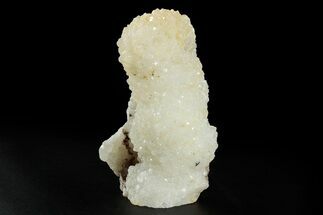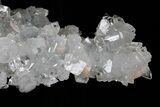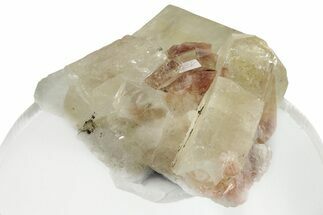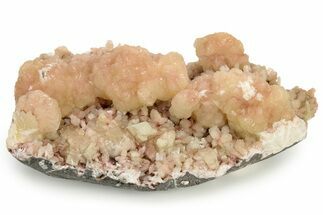This Specimen has been sold.
6.5" Apophyllite and Stilbite on Quartz Chalcedony Stalactites - India
This is a breathtaking, 6.5" wide by 5.6" tall mineral association containing lustrous, double-terminated apophyllite crystals, peach colored stilbite crystals and quartz/chalcedony. The quartz chalcedony formed as stalactites along the ceiling of a cavity, with apophyllite and stilbite crystals that formed over the quartz stalactite. This gorgeous specimen was collected from Maharashtra, India.
This specimen comes from the Deccan Traps, a large igneous province and one of the largest volcanic features on Earth, near the city of Pune in western India. As miners quarry for other materials or dig wells, they sometimes unearth large pockets of zeolites and other minerals in the volcanic rock.
Stilbite is probably the most common zeolite found in these deposits. Crystals often form flowery, bowtie. or hourglass-shaped structures and come in a variety of colors. Some of the most beautiful colorations are the pink or peach tints. While not a zeolite itself, apophyllite is almost always found associated with zeolites in the same pockets. It has two crystal habits: a rectangular prism capped by a steep four-sided pyramid, or a pseudo-cubic structure. While not a well-known mineral to the general public, it is popular among mineral collectors due to its pastel colors and beautiful crystal formations.
Stilbite is probably the most common zeolite found in these deposits. Crystals often form flowery, bowtie. or hourglass-shaped structures and come in a variety of colors. Some of the most beautiful colorations are the pink or peach tints. While not a zeolite itself, apophyllite is almost always found associated with zeolites in the same pockets. It has two crystal habits: a rectangular prism capped by a steep four-sided pyramid, or a pseudo-cubic structure. While not a well-known mineral to the general public, it is popular among mineral collectors due to its pastel colors and beautiful crystal formations.
About Quartz
Quartz is the name given to silicon dioxide (SiO2) and is the second most abundant mineral in the Earth's crust. Quartz crystals generally grow in silica-rich environments--usually igneous rocks or hydrothermal environments like geothermal waters--at temperatures between 100°C and 450°C, and usually under very high pressure. In either case, crystals will precipitate as temperatures cool, just as ice gradually forms when water freezes. Quartz veins are formed when open fissures are filled with hot water during the closing stages of mountain formation: these veins can be hundreds of millions of years old.
Quartz is the name given to silicon dioxide (SiO2) and is the second most abundant mineral in the Earth's crust. Quartz crystals generally grow in silica-rich environments--usually igneous rocks or hydrothermal environments like geothermal waters--at temperatures between 100°C and 450°C, and usually under very high pressure. In either case, crystals will precipitate as temperatures cool, just as ice gradually forms when water freezes. Quartz veins are formed when open fissures are filled with hot water during the closing stages of mountain formation: these veins can be hundreds of millions of years old.
Chalcedony is any microcrystalline variety of silica composed of very fine intergrowths of quartz and mogánite: microcrystalline minerals have microscopic crystals that cannot be observed by the naked eye. Both quartz and mogánite have the same chemical formula SiO2 (silicon dioxide), but different crystal structures. When free from impurities, chalcedony is colorless and transparent. Depending on impurities present during formation, chalcedony can form in a wide variety of colors including red, yellow, green, blue, purple, grey, white, and numerous hues in between. Chalcedony is quite hard at 7 on the Mohs Hardness Scale: this matches its main component quartz, which is the benchmark mineral for the scale at 7.
SPECIES
Apophyllite, Stilbite, Quartz & Quartz var. Chalcedony
LOCATION
Maharashtra, India
SIZE
6.5" wide, 5.6" tall
CATEGORY
ITEM
#176838
 Reviews
Reviews

















